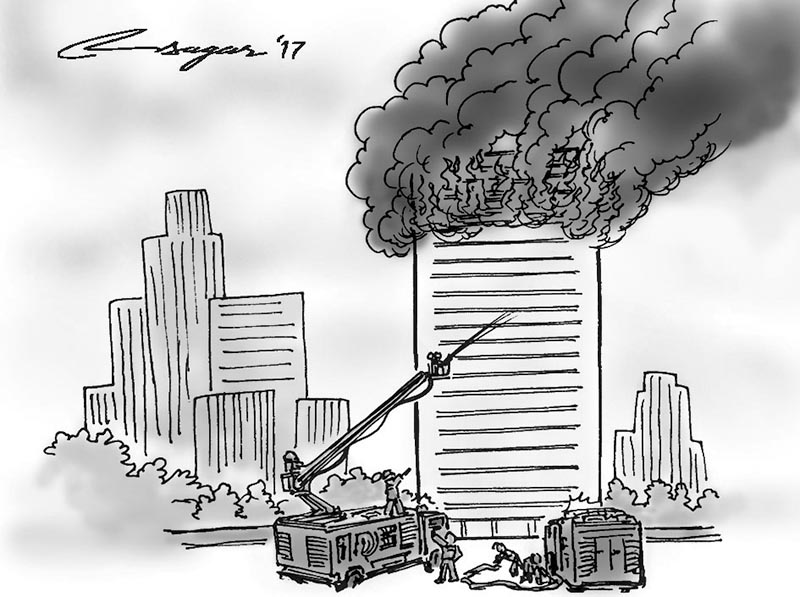Nepal’s tall buildings: Fire safety concerns
Ensuring “Public Safety for All” in tall buildings is quite complex. In addition to structural safety (safety from dynamic forces such as earthquakes and wind), non-structural safety from fires must be fully considered and designed meeting all safety requirements
Recent fires in high rise buildings raise important public safety concerns about fire safety in Nepal’s tall buildings and other structures. Challenges persist. Potential for disastrous consequences from fires hasn’t appeared in the mindset of Nepal’s infrastructure developers. In reality, Nepal has just begrudgingly started to accept and half-heartedly addresses the dangers from natural or man-made disasters after experiencing the after-effects of the massive 2015 Gorkha-Nepal Earthquake.
These fire incidents should serve as an awakening call for all – professionals, regulators and the public. Professionals, regulators and the public, educated about the issue of fire safety for all in buildings, will save lives.
Loss of life and the destruction to property by man-made fire disasters or natural disasters such as earthquakes, floods, high winds, etc. can be diminished by judicious decisions that are based on the state of the science and as reflected through evolving building codes.
Fire safety considerations involve consideration of numerous issues. Tall buildings are associated with their own special risks. The level of fire risk in smaller buildings depends on their fire load and includes their use and materials of construction. The risk to the number of people using that building facility must be considered.
Ensuring fire safety involves addressing many concept. Some of them include monitored alarm systems, fire sprinkler types and their design, fire exits, fire doors, smoke seal, anchorage of fire suppression piping and systems against earthquake forces, and others.
Issues such as smoke protection and fire protection, non-toxic fire suppressant systems, structural fire protection and impact on structural design must be addressed.
“Public Safety for All including People with Disabilities and the Elderly (PSFA) “, if a priority, must address the inadequacy of fire-fighting resources in Nepal.The tragic aftermath from the 2015 Gorkha-Nepal Earthquake stands as testimony to the lack of attention paid to fire-fighting resources.
The Patan Fire House is completely destroyed. The condition of Juddha Barun Yantra building in Kathmandu is pathetic. The conditions at the fire stations, infrastructure development and inadequate oversights and community building design practices manifest these inadequacies. Antiquated systems cannot meet the needs of today’s Kathmandu Valley.
An anticipated consequence during the 2015 earthquake were fires in building originating from the storage of “natural gas” cylinders in homes. Luckily, such news did not dominate the airwaves. The best practice in Nepal of shutting off the valves of the gas cylinders were claimed to be the reason for lack of fire during the past earthquake.
Still, the fire dangers prevail. The experience of the fire at Paltan Ghar in 2012 cannot be forgotten. Nepal has not shown that it has taken the risk from fires very seriously.
Quality control of materials used in the construction of tall buildings in Nepal remains an issue. Do products that are used in Nepal, starting from the simple nuts and bolts to materials such as cladding, utility lines, connection, and partitions have the appropriate fire rating for the types of construction and the use of the structure?
Reports indicate that the West London Grenfell Tower and Hawaii’s Marco Polo Condominium buildings were not fitted with sprinklers. Modern codes require functioning fire sprinklers in tall buildings and public buildings holding large number of occupants such as malls and theaters (large gathering places), offices, schools, hotels, apartments etc. Such facilities are inspected annually and the fire suppression systems, such as fire sprinklers, certified.
In addition, modern codes require an emergency backup system of water in tanks in tall buildings. The backup system is required in addition to the pressurized public water system in modern cities.
In Nepal, tall buildings are required to have water tank as the primary source of water to fight fires. How they are inspected, their adequacy, location, etc remains an unresolved question.
Fire hydrants initially installed in Kathmandu in the early 1900s are now a rarity and pressurized public water system is still to come into operation. The old is gone and non-functional. A question should be asked. “Does the much anticipated Melamchi water supply system have fire hydrant installation provisions”. Ensuring “Public Safety for All” in tall buildings is quite complex.
In additional to structural safety (safety from dynamic forces such as earthquakes and wind), non-structural safety from fires must be fully considered and designed meeting safety requirements enforced.
Hawaii has decided to change laws and require all old buildings over 10 story to be retrofitted with fire sprinkler systems after the recent Marco Polo Condominium Fire.
The reach height of modern fire trucks is limited to 75 feet. The 10 story criteria makes sense as the building height will be around 75 feet. These considerations, if adopted in Nepal’s tall building design and construction, will save lives.
Baidya is a California based licensed engineer






